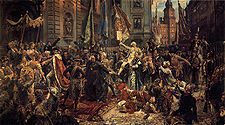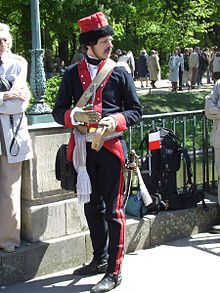- May 3rd Constitution Day
-
May 3rd Constitution Day 
May 3rd Constitution, by Matejko. King Stanisław August (left) enters St. John's Cathedral, where deputies will swear to uphold the Constitution.Official name Święto Konstytucji 3 Maja Observed by Polish people Type national, secular, patriotic Significance Establishment of the Constitution of May 3, 1791 Date May 3 Celebrations Parades May 3 National Holiday (May-3rd-Constitution Day—Święto Konstytucji 3 Maja) is a Polish national and public holiday that takes place on May 3. The holiday celebrates the declaration of the Constitution of May 3, 1791. Festivities date back to the Duchy of Warsaw early in the 19th century, but it became an official holiday only in 1919 in the Second Polish Republic. Delisted during the times of the People's Republic of Poland, it was reestablished after the fall of communism in modern Poland.
Contents
Background
 May 3 parade in Łódź, Poland, 2010
May 3 parade in Łódź, Poland, 2010
The Constitution of May 3, 1791 is considered one of the most important achievements in the history of Poland, despite being in effect for only a year, until the Russo-Polish War of 1792. Historian Norman Davies calls it "the first constitution of its type in Europe"; other scholars also refer to it as the world's second oldest constitution.[a][1][2][3][4]
The May 3rd Constitution was designed to redress long-standing political defects of the Polish–Lithuanian Commonwealth. The Constitution sought to supplant the existing anarchy fostered by some of the country's magnates with a more democratic constitutional monarchy. The adoption of the May 3rd Constitution provoked the active hostility of the Commonwealth's neighbors, leading to the Second Partition of Poland in 1792, the Kościuszko Uprising of 1794 and the final, Third Partition of Poland, in 1795. In the words of two of its co-authors, Ignacy Potocki and Hugo Kołłątaj, it was "the last will and testament of the expiring Fatherland."[5]
The memory of the May 3 Constitution—recognized by political scientists as a very progressive document for its time—for generations helped keep alive Polish aspirations for an independent and just society, and continued to inform the efforts of its authors' descendants.[6] In Poland it is viewed as a national symbol, and the culmination of all that was good and enlightened in Polish history and culture.[6]
The May 3 anniversary of its adoption has been observed as Poland's most important civil holiday since Poland regained independence in 1918.[7] Its importance for the Polish people has been compared to that of July 4 to the Americans.[8]
Celebrations
 Polish cavalryman in traditional dress uniform during the celebrations of May 3, 2007
Polish cavalryman in traditional dress uniform during the celebrations of May 3, 2007
May 3 was first declared a holiday on May 5, 1791, and celebrated a year later, on May 3, 1792.[9][10] Banned during the partitions of Poland it was celebrated in the Duchy of Warsaw in 1807, and unofficially in Congress Poland by various pro-independence activists, more openly during the times of insurrections, such as the November Uprising.[9][10][11] It was again made an official Polish holiday in April 1919 under the Second Polish Republic—the first holiday officially introduced in the Second Polish Republic.[7] The May 3 holiday was banned once more during World War II by the Nazi and Soviet occupiers. It was celebrated in the Polish cities in May 1945, although in a mostly spontaneous manner.[7] The celebrations were officially canceled shortly before May 3 in 1946, and the anti-communist demonstrations took place later that day.[7] This, and the competition the date created with the communist-endorsed May 1 Labor Day celebrations, meant that the May 3 Constitution Day lost support with the authorities of the Polish People's Republic.[7][9][10] In 1947 it was officially rebranded Democratic Party Day and removed from the list of national holidays either then or on 1951 (sources vary).[7][9] Until 1989, May 3 was a common day for anti-government and anti-communist protests.[7] May 3 was restored as an official Polish holiday in April 1990, after the fall of communism.[9] In 2007, May 3 was also declared a Lithuanian national holiday; the first joint celebration by the Polish Sejm and the Lithuanian Seimas took place on May 3, 2007.[12]
In modern Poland, this day, free from work, sees many parades, exhibitions, concerts and public figure speeches.[13] Most important Polish politicians participate in those festivities; for example in 2011 President of Poland, Bronisław Komorowski, Prime Minister of Poland, Donald Tusk, and Marshal of the Sejm, Grzegorz Schetyna, Marshal of the Senate, Bogdan Borusewicz, and Minister of National Defence, Bogdan Klich, took part in the festivities in Warsaw.[13] The official festivities in Warsaw included flag flying, cannon salvos, reading of the constitution preamble, and singing a patriotic song from the November Uprising, Witaj, majowa jutrzenko (Welcome, May Dawn).[13] Other events of that day in Warsaw included a celebratory mass in St. John's Archcathedral, Warsaw, and presidential awards for achievements in the field of advancing Polish culture.[13]
The holiday has been a focal point of ethnic celebrations of Polish-American pride in the Chicago area, where it is known as Polish Constitution Day, since 1892.[14] Poles in Chicago have continued this tradition to the present day, marking it with festivities and the annual Polish Constitution Day Parade; guests of national stature, most notably Bobby Kennedy, have attended over the years as a way to ingratiate themselves with Chicago Polonia.[14][15] In Minnesota, first celebrations date to 1870s.[16] In San Francisco, the anniversary of the May 3rd Constitution has been observed annually for decades in the Music Concourse at Golden Gate Park.[17]
Notes
a ^ The claims of "first" and "second constitution" have been disputed. Indeed, both documents in question (US and Polish constitutions) were preceded by earlier ones, including those also labelled as constitutions, e.g., the Corsican Constitution of 1755.*[18] See History of the constitution for more information.
References
- ^ Albert P. Blaustein (1993). Constitutions of the world. Wm. S. Hein Publishing. p. 15. ISBN 9780837703626. http://books.google.com/books?id=2xCMVAFyGi8C&pg=PA15. Retrieved 30 May 2011.
- ^ Bill Moyers (5 May 2009). Moyers on Democracy. Random House Digital, Inc.. p. 68. ISBN 9780307387738. http://books.google.com/books?id=f42INaX6uX8C&pg=PA68. Retrieved 30 May 2011.
- ^ Sandra Lapointe; Jan Wolenski; Mathieu Marion (2009). The Golden Age of Polish Philosophy: Kazimierz Twardowski's Philosophical Legacy. Springer. p. 4. ISBN 9789048124008. http://books.google.com/books?id=5u84tl5ux0gC&pg=PA4. Retrieved 30 May 2011.
- ^ Davies, Norman (1996). Europe: A History. Oxford University Press. p. 699. ISBN 0198201710. http://books.google.com/books?id=jrVW9W9eiYMC&pg=PA699.
- ^ Machnikowski (1 December 2010). Contract Law in Poland. Kluwer Law International. p. 20. ISBN 9789041133960. http://books.google.com/books?id=Iu___HYTHDkC&pg=PA20. Retrieved 12 July 2011.
- ^ a b George Sanford (2002). Democratic government in Poland: constitutional politics since 1989. Palgrave Macmillan. p. 11. ISBN 9780333774755. http://books.google.com/books?id=tOaXi0hX1RAC&pg=PA11. Retrieved 5 July 2011.
- ^ a b c d e f g (Polish) Rafał Kowalczyk and Łukasz Kamiński, Zakazane święta PRLu, Polskie Radio Online, May 3, 2008. Retrieved on 4 July 2011 (from the Internet Archive)
- ^ Victor Zarnowitz (August 2008). Fleeing the Nazis, surviving the Gulag, and arriving in the free world: my life and times. ABC-CLIO. p. 6. ISBN 9780313357787. http://books.google.com/books?id=Uy9ytlZjTEoC&pg=PA6. Retrieved 13 July 2011.
- ^ a b c d e (Polish) historyczny.pdf Konstytucja 3 Maja – rys historycznyPDF , University of Warsaw. Retrieved on 4 July 2011 (from the Internet Archive)
- ^ a b c (Polish) Adam Kożuchowski, Testament konającej republiki: Jak to było z Konstytucją 3 Maja, Polityka, 3 May 2011. Retrieved in 12 July 2011
- ^ (Polish) Iwona Pogorzelska, Prezentacja na podstawie artykułu Romany Guldon „Pamiątki Konstytucji 3 Maja przechowywane w zasobie Archiwum Państwowego w Kielcach."PDF (4.14 MB) Almanach Historyczny, T. 4, Kielce 2002. Retrieved on 4 July 2011
- ^ (Polish) Rok 2007: Przegląd wydarzeń, Tygnodnik Wileńszczyzny. Retrieved on 4 July 2011
- ^ a b c d (Polish) Święto Konstytucji 3 Maja: „Nikt nie ma Polski na wyłączną własność”, TVP.pl, 3 May 2011. Retrieved on 12 July 2011
- ^ a b Polish Constitution Day - Chicago 2011 - Mayor Daley's Last Parade, Polonia Music. Retrieved on 4 July 2011.
- ^ Thousands Attend Polish Constitution Day Parade. CBS. May 7, 2011. Retrieved on 4 July 2011
- ^ John Radzilowski (15 February 2005). Poles in Minnesota. Minnesota Historical Society. p. 41. ISBN 9780873515160. http://books.google.com/books?id=b2DOHhitMI0C&pg=PT41. Retrieved 13 July 2011.
- ^ [1] Annual Polish May 3rd Constitution Day celebration at Golden Gate Park in San Francisco
- ^ Dorothy Carrington (1973), "The Corsican Constitution of Pasquale Paoli (1755–1769)", The English Historical Review, 88:348 (July), p. 482. JSTOR 564654
 Polish Wikiquote has quotations related to: May 3rd Constitution DayCategories:
Polish Wikiquote has quotations related to: May 3rd Constitution DayCategories:- Holidays in Lithuania
- Holidays in Poland
- Secular holidays
- Recurring events established in 1919
Wikimedia Foundation. 2010.
